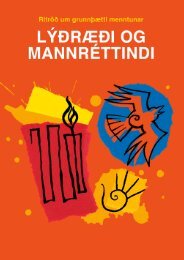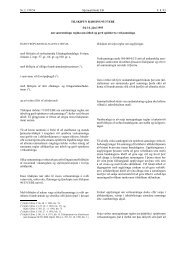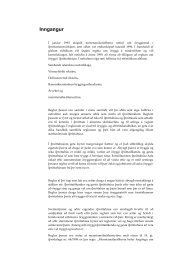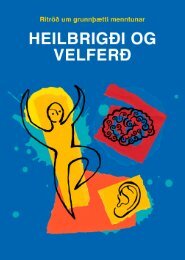Nomination of
Nomination of
Nomination of
Create successful ePaper yourself
Turn your PDF publications into a flip-book with our unique Google optimized e-Paper software.
SURTSEY – NOMINATION FOR THE UNESCO WORLD HERITAGE LIST<br />
Shore community on the northern coast <strong>of</strong> Surtsey,<br />
composed <strong>of</strong> sea sandwort, lyme grass, oyster plant<br />
and sea rocket. (Photo: Borgþór Magnússon 2005).<br />
the surface layer (0–20 mm) that were collected at<br />
21 localities in July 1972. No soil- or freshwaterinhabiting<br />
aquatic fungi were found on Surtsey<br />
between 1964 and 1972, when their possible<br />
presence was being monitored by T. W. Johnson<br />
together with his students and co-workers.<br />
The first mushroom, Arrhenia rustica, was<br />
found in several places in 1975, growing among<br />
mosses. In 1990 it was common in the bird colony<br />
(Sturla Friðriksson 2005). A second agaric<br />
species was collected once in 1975, an unidentified<br />
Galerina sp. In June 1990 three discomycetes<br />
were collected, Peziza varia growing along the<br />
32<br />
concrete foundation <strong>of</strong> the hut, Lamprospora<br />
crouanii growing amongst low moss on sloping<br />
palagonite tuff at Strompur, and Octospora<br />
auxillaris growing on sand amongst Bryum near a<br />
fish bone. In 1994 the feather stalkball Onygena<br />
corvina grew on feathers from a regurgitated bird<br />
pellet. In the last ten years a Panaeolus sp. has<br />
been found among grasses in the bird colony and<br />
recently the silky pinkgill Entoloma sericeum was<br />
added to that community. In 2005 two agarics,<br />
mycorrhizal partners <strong>of</strong> the tea-leaved willow had<br />
produced fruiting bodies around the plant.<br />
Studies in 1996 on the microbial activity in<br />
three different soils (Frederiksen et al. 2000)<br />
showed that there were few fungal hyphae in<br />
bare soil, a medium number in areas with shore<br />
community, while by far the most hyphae were<br />
measured in the soils <strong>of</strong> the gull colony.<br />
Vegetation<br />
Plants have dispersed and become established in<br />
all parts <strong>of</strong> Surtsey. The only sections <strong>of</strong> the island<br />
which remain mostly devoid <strong>of</strong> plant life are the<br />
steep palagonite hills in the middle <strong>of</strong> the island.<br />
However, the plant cover is still relatively thin,<br />
except at the gull colony on the southern lava<br />
plain (Fig. 2.12), where dense and rather diverse<br />
vegetation has developed over the last 20 years.<br />
In 2004, vegetation analyses <strong>of</strong> the permanent<br />
Lava community on southern Surtsey. Procumbent pearlwort, reflexed saltmarsh-grass and scurvygrass are the most<br />
prominent species in this community. (Photo: Borgþór Magnússon 2004).



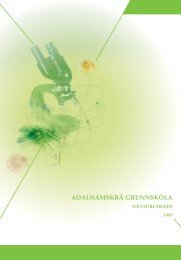
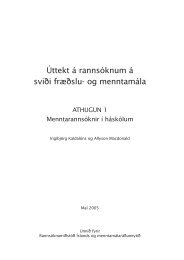


![Aðalnámskrá tónlistarskóla : rytmÃsk tónlist [Eingöngu á rafrænu formi]](https://img.yumpu.com/50843672/1/184x260/aaalnamskra-tanlistarskala-rytma-sk-tanlist-eingangu-a-rafranu-formi.jpg?quality=85)
